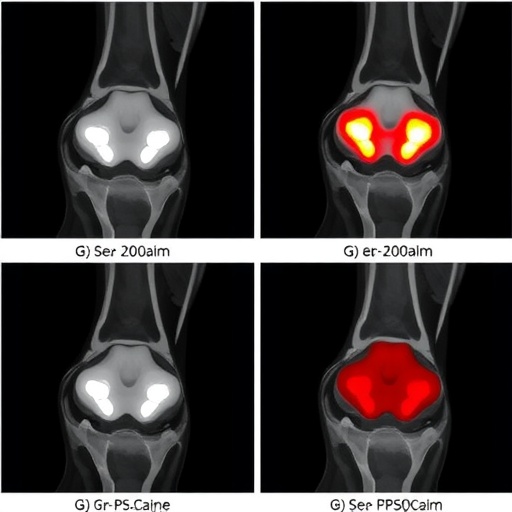In a groundbreaking study, researchers have introduced an innovative approach to meniscus injury detection that could significantly enhance the efficacy of medical imaging diagnostics. By integrating the state-of-the-art MobileNetV3 deep learning architecture with a Support Vector Machine (SVM) classification system, this research aims to bridge the gap between traditional diagnostic methods and advanced computational techniques. Meniscal injuries, which commonly affect individuals engaged in sports and physical activities, often lead to complex diagnoses due to the subtlety of radiographic signs. This pioneering work not only enhances detection rates but also provides crucial interpretative clarity through advanced visualization techniques, specifically Grad-CAM.
The study emphasizes the necessity of a holistic approach to meniscus injury detection, where the amalgamation of artificial intelligence and medical expertise offers profound improvements. Leaves of ambiguity in traditional imaging practices often lead to misdiagnoses, which can have detrimental consequences for patient outcomes. By leveraging the strengths of MobileNetV3—a lightweight convolutional neural network known for its efficiency and high accuracy—the researchers present a solution that minimizes computational costs while maximizing diagnostic precision. This breakthrough is particularly relevant in clinical settings where time-efficient analysis can make a difference in patient care.
Grad-CAM (Gradient-weighted Class Activation Mapping) visualization is employed as a complementary tool in this research endeavor. This technique enhances the interpretability of the AI model’s predictions by producing visual heatmaps that highlight areas of importance in the imaging data. Clinicians can discern the regions of interest that inform the model’s decision-making process, thus fostering greater trust in automated systems. The synergy between MobileNetV3’s deep learning capabilities and Grad-CAM’s visualization metrics empowers radiologists with richer, contextual insights into meniscus injuries.
The implications of this study extend beyond mere diagnostic accuracy. Improved detection methodologies can facilitate earlier interventions, leading to better patient prognoses and optimized surgical planning. In a field where misinterpretations can lead to unnecessary invasive procedures, the high sensitivity and specificity rates demonstrated by the MobileNetV3-SVM model are promising. The researchers assert that the judicious application of their framework can not only streamline clinical workflows but also reduce the overall burden on healthcare systems.
A unique aspect of this research is its inspiration drawn from the nuanced understanding of radiologists. By incorporating the perceptive expertise of medical professionals into the training of the AI system, the researchers have created a hybrid model that reflects clinical judgment rather than purely algorithmic analysis. This integrative methodology offers an unprecedented level of diagnostic support, ensuring that the AI model operates as an augmentation to human decision-making rather than a stand-alone entity.
Moreover, this study provides an essential reference point for future research centered around the intersection of AI and radiology. By transparently sharing their methodologies and findings, the authors set a benchmark for subsequent investigations aiming to further refine automated diagnostic tools. The clinical community is urged to adopt these innovations as viable adjuncts in practice, heralding a new era of diagnostic excellence.
With an eye towards the future, the researchers also highlight the vital role of continuous learning in AI models. As new data becomes available and clinical practices evolve, there is an imperative need for the algorithms to adapt and improve. This adaptability will require further training cycles and validation studies to ensure sustained performance levels in diverse populations and clinical scenarios. Implementing such adaptive strategies could enhance the long-term viability of these systems in rapidly changing healthcare environments.
The potential for scalability is another exciting facet of this research. MobileNetV3’s architecture is well-suited for deployment in resource-constrained settings, making this technology accessible to a broader spectrum of medical facilities globally. This is particularly significant in developing regions, where the expertise and resources for sophisticated imaging analyses may be limited. The democratization of advanced diagnostic tools can bridge inequalities in healthcare access and improve outcomes for countless patients.
Additionally, the authors encourage interdisciplinary collaborations in further developing the model. Engaging with technologists, data scientists, and healthcare professionals will not only enhance the robustness of the model but also inspire diverse applications across various types of musculoskeletal injuries beyond the meniscus. The overarching goal is to cultivate an ecosystem where AI serves as a foundational tool in diagnostic radiology, capable of addressing a myriad of conditions with precision and reliability.
Patients stand to benefit directly from advancements in meniscus injury detection technology. With improved diagnostic accuracy and visualization support, individuals suffering from knee pain will have more confidence in their diagnostic process. A transparent and explainable AI approach can lead to more informed patient decisions regarding treatment options, whether conservative management or surgical intervention. Ultimately, a more engaged patient base can enhance compliance with medical recommendations and improve overall health outcomes.
In conclusion, this pioneering research represents a formidable leap forward in the realm of medical imaging for meniscus injury detection. By harnessing cutting-edge technology, the authors have crafted a compelling narrative around the profound implications of AI in diagnostics. The findings resonate with the call for innovation in medical practices, underscoring the distinctive advantages of integrating artificial intelligence into daily clinical workflows. As the medical community begins to adopt such transformative technologies, the future looks promising for enhanced patient care and improved health systems globally.
The significance of this study cannot be overstated, as it heralds a wave of innovation in radiological practices. As healthcare continues to evolve with technological advancements, the blend of human expertise and machine learning presents boundless opportunities. The message from this research is clear: the future of medical imaging lies in collaboration, interpretation, and the seamless incorporation of AI into our diagnostic arsenal.
Subject of Research: Meniscus Injury Detection
Article Title: Radiologist-Inspired Meniscus Injury Detection Using MobileNetV3-SVM with Grad-CAM Visualization
Article References: Choudhary, P., Jaiswal, A., Dash, D. et al. Radiologist-Inspired Meniscus Injury Detection Using MobileNetV3-SVM with Grad-CAM Visualization. J. Med. Biol. Eng. (2025). https://doi.org/10.1007/s40846-025-00991-y
Image Credits: AI Generated
DOI: https://doi.org/10.1007/s40846-025-00991-y
Keywords: MobileNetV3, SVM, Grad-CAM, meniscus injury detection, medical imaging, artificial intelligence, radiology.
Tags: advanced imaging for sports injuriesartificial intelligence in healthcare diagnosticscomputational techniques in medical imagingdeep learning architecture in radiologyefficient diagnostic methods for meniscal injuriesenhancing diagnostic precision with machine learningGrad-CAM visualization techniquesholistic approach to injury detectionimproving patient outcomes through AIminimizing misdiagnoses in radiographic practicesMobileNetV3 meniscus injury detectionSVM classification system in medical imaging





